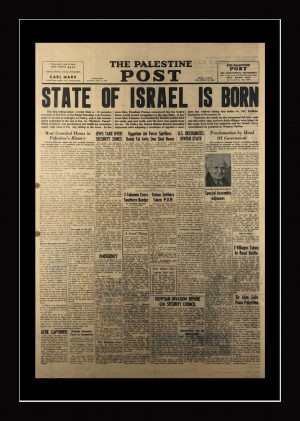Shop
Time Magazine Six Day War “How Israel Won The War” June 16 1967
$500.00
SOLD
Description
Full Time Magazine Six Day War “How Israel Won The War” June 16 1967
On The Front page General Mosh Dayan
The Six-Day War (Hebrew: מלחמת ששת הימים, Milhemet Sheshet Ha Yamim; Arabic: النكسة, an-Naksah, “The Setback” or حرب ۱۹٦۷, Ḥarb 1967, “War of 1967”), also known as the June War, 1967 Arab–Israeli War, or Third Arab–Israeli War, was fought between June 5 and 10, 1967 by Israel and the neighboring states of Egypt (known at the time as the United Arab Republic), Jordan, and Syria. Relations between Israel and its neighbours had never fully normalised following the 1948 Arab–Israeli War. In the period leading up to June 1967, tensions became dangerously heightened. In reaction to the mobilisation of Egyptian forces along the Israeli border in the Sinai Peninsula, Israel launched a series of preemptive airstrikes against Egyptian airfields. The Egyptians were caught by surprise, and nearly the entire Egyptian air force was destroyed with few Israeli losses, giving the Israelis air superiority. Simultaneously, the Israelis launched a ground offensive into the Gaza Strip and the Sinai, which again caught the Egyptians by surprise. After some initial resistance, Egyptian leader Gamal Abdel Nasser ordered the evacuation of the Sinai. Israeli forces rushed westward in pursuit of the Egyptians, inflicted heavy losses, and conquered the Sinai. Nasser induced Syria and Jordan to begin attacks on Israel by using the initially confused situation to claim that Egypt had defeated the Israeli air strike. Israeli counterattacks resulted in the seizure of East Jerusalem as well as the West Bank from the Jordanians, while Israel’s retaliation against Syria resulted in its occupation of the Golan Heights. On June 11, a ceasefire was signed. Arab casualties were far heavier than those of Israel: fewer than a thousand Israelis had been killed compared to over 20,000 from the Arab forces. Israel’s military success was attributed to the element of surprise, an innovative and well-executed battle plan, and the poor quality and leadership of the Arab forces. Israel seized control of the Gaza Strip and the Sinai Peninsula from Egypt, the West Bank and East Jerusalem from Jordan, and the Golan Heights from Syria. Israeli morale and international prestige was greatly increased by the outcome of the war and the area under Israeli control tripled. However, the speed and ease of Israel’s victory would lead to a dangerous overconfidence within the ranks of the IDF, contributing to initial Arab successes in the subsequent 1973 Yom Kippur War. The displacement of civilian populations resulting from the war would have long-term consequences, as 300,000 Palestinians fled the West Bank and about 100,000 Syrians left the Golan to become refugees. Across the Arab world, Jewish minority communities were expelled, with refugees going to Israel or Europe. WIKI
Framed
Additional Information
| Artist / Creator | |
|---|---|
| Year | |
| Condition | |
| Technique | |
| A |


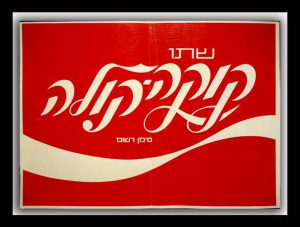 RARE Vintage Israeli Sign Advertisement For COCA COLA In Hebrew 1950s
RARE Vintage Israeli Sign Advertisement For COCA COLA In Hebrew 1950s
 “Yom HaMedinah” Newspaper – for She’erit HaPleta in Dusseldorf, State of Israel is Born, original newspaper from 1948
“Yom HaMedinah” Newspaper – for She’erit HaPleta in Dusseldorf, State of Israel is Born, original newspaper from 1948
 Vaction in Israel, Israel Vintage Travel Poster 1960
Vaction in Israel, Israel Vintage Travel Poster 1960
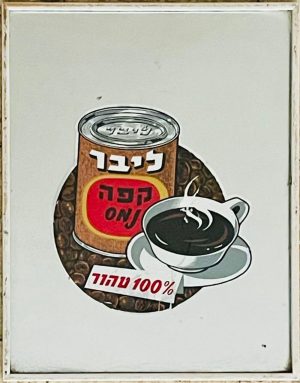 Israeli Coffee Sign on Glass 1950s
Israeli Coffee Sign on Glass 1950s
 VINTAGE ISRAEL POSTER JEWISH SOVIET REFUSENIKS LET MY PEOPLE GO 1977
VINTAGE ISRAEL POSTER JEWISH SOVIET REFUSENIKS LET MY PEOPLE GO 1977
 Israeli Vintage Carmel Winery Advertisement On Tin Sign 1950s
Israeli Vintage Carmel Winery Advertisement On Tin Sign 1950s
 Vintage Kosher Tin Sign for Butcher Shop Palestine Ertz Israel
Vintage Kosher Tin Sign for Butcher Shop Palestine Ertz Israel
 "Davar Hashavua" Rare Weekly Newspaper During The War of Independence 13.4.1948
"Davar Hashavua" Rare Weekly Newspaper During The War of Independence 13.4.1948
 Washing Powder "Pearls of Light" SHEMEN COMPANY vinatge israeli Poster 1960s
Washing Powder "Pearls of Light" SHEMEN COMPANY vinatge israeli Poster 1960s
 Rare Children's Book "Products From Palestine Eretz Israel 1940s
Rare Children's Book "Products From Palestine Eretz Israel 1940s
 "Field Hospital Original Photo Of Yom Kippur war, Egyptian front 1973 by Uri Dan
"Field Hospital Original Photo Of Yom Kippur war, Egyptian front 1973 by Uri Dan
 LIFE Magazine 1967 June 23 Israeli War Sinai Battle Six Days War Israel
LIFE Magazine 1967 June 23 Israeli War Sinai Battle Six Days War Israel
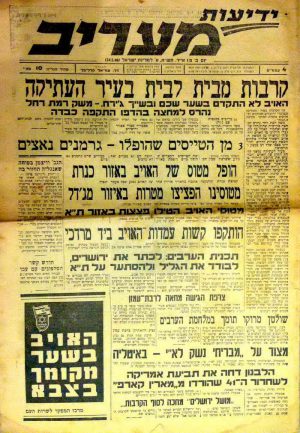 Israel's War for independence, Fighting inside the old city of Jerusalem, Israel 1948
Israel's War for independence, Fighting inside the old city of Jerusalem, Israel 1948
 RARE Newspaper – Poland Warsaw 15.5.1948 Decleration of Israel's Independence
RARE Newspaper – Poland Warsaw 15.5.1948 Decleration of Israel's Independence
 Israeli Vintage Carmel Winery Advertisement On Tin Sign 1950s
Israeli Vintage Carmel Winery Advertisement On Tin Sign 1950s
 "Visit The Land Of the Bible" Tourism Poster Jean David 1950sI srael,
"Visit The Land Of the Bible" Tourism Poster Jean David 1950sI srael,
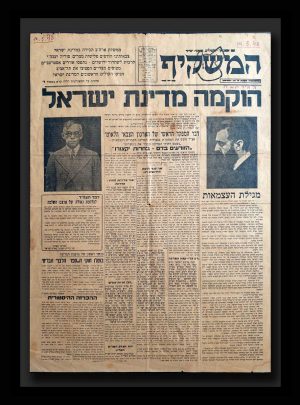 Rare Israeli Newspaper Declaration of Independence!, 1948 Jabotinsky & Herzl
Rare Israeli Newspaper Declaration of Independence!, 1948 Jabotinsky & Herzl


